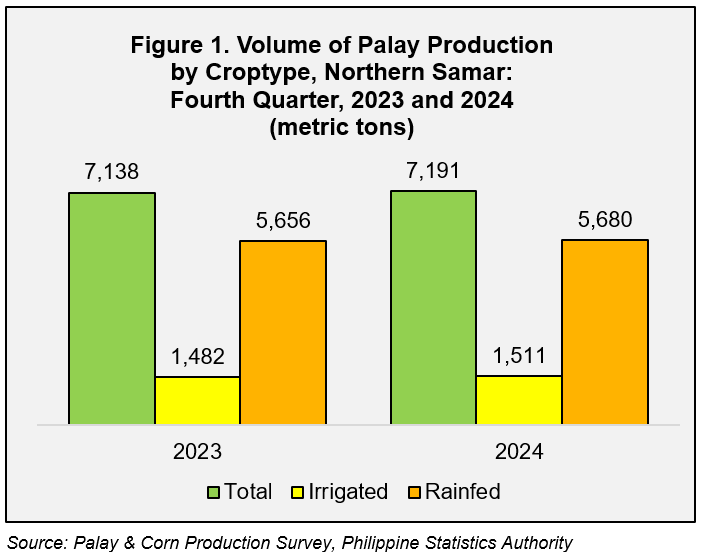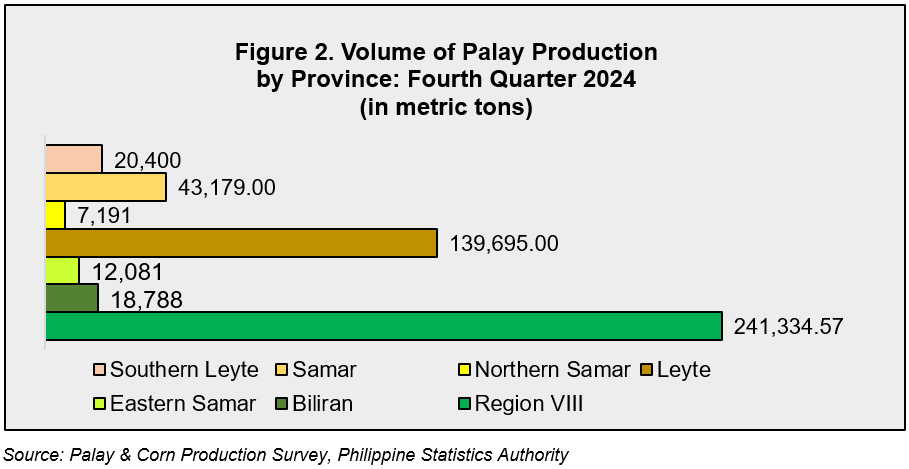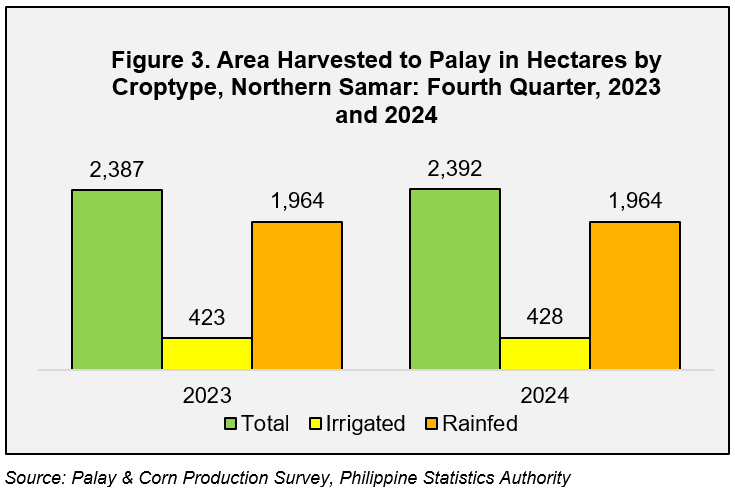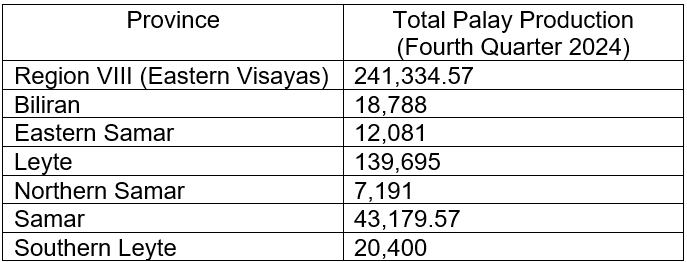The Philippine Statistics Authority (PSA) reports the latest palay production and harvested area estimates for Northern Samar in the fourth quarter of 2024, based on data gathered from the Palay and Corn Production Survey (PCPS). This quarterly survey provides comprehensive statistics on production volume, yield per hectare, and total area harvested for both palay and corn, serving as a vital input for agricultural planning and policy-making.
In the fourth quarter of 2024, Northern Samar recorded a palay production volume of 7,191 metric tons, showing a slight increase compared to the 7,138 metric tons produced in the same quarter of 2023. This reflects a year-on-year increase of
53 metric tons, equivalent to a 0.74 percent growth.
The modest growth may indicate improvements in farming practices, favorable weather conditions, or possibly an expansion in the area harvested or yield per hectare. Although the increase is not substantial, it suggests a stable or slightly improving agricultural output for palay in the province during the observed period.
Table 1. Volume of Palay Production in Metric Tons Northern Samar
Fourth Quarter of 2023 & 2024

Figure 1 shows that Northern Samar recorded a total palay production of 7,191 metric tons, reflecting a year-on-year increase of 53 metric tons or 0.74 percent compared to the 7,138 metric tons produced during the same period in 2023. This slight growth indicates relatively stable production conditions in the province. Furthermore, irrigated palay production increased from 1,482 metric tons in the fourth quarter of 2023 to 1,511 metric tons in the same quarter of 2024, posting a gain of 29 metric tons or 1.96 percent. Similarly, rainfed palay production showed a slight increase, rising from 5,656 metric tons to 5,680 metric tons, equivalent to a 24-metric ton increase or 0.42 percent growth. The increase in irrigated palay output may be attributed to improved irrigation systems or more consistent water supply, while the rise in rainfed production could be linked to favorable weather conditions during the cropping period. These figures underscore the importance of both irrigated and rainfed areas in maintaining the province's rice production performance.

Moreover, figure 2 presented that Region VIII (Eastern Visayas) recorded a total palay production of 241,334.57 metric tons, reflecting the region’s continued contribution to the country's rice supply. Among the provinces, Leyte registered the top producer with 139,695 metric tons, accounting for about 57.88 percent of the region's total output. This was followed by Samar, which contributed 43,179.57 metric tons or around 17.89 percent, and Biliran with 18,788 metric tons or 7.79 percent. Southern Leyte produced 20,400 metric tons, while Eastern Samar and Northern Samar reported total palay production of 12,081 metric tons and 7,191 metric tons, respectively. The combined palay production of these three provinces contributed approximately 16.44 percent to the total regional production. This provincial breakdown provides insight into production concentration within the region and supports data-driven planning and resource allocation to sustain and enhance palay output across Eastern Visayas.

Figure 3 presented that the total area harvested for palay in Northern Samar slightly increased compared to the same period in 2023. The total area harvested increased from 2,387 hectares to 2,392 hectares, reflecting a year-on-year growth of 5 hectares, or 0.21 percent. The area harvested for irrigated palay increased from 423 hectares in 2023 to 428 hectares in 2024, marking a 1.18 percent increase. This increase may indicate improvements in irrigation infrastructure or more favorable water availability during the period. In contrast, the area harvested for rainfed palay remained unchanged at 1,964 hectares, suggesting stable conditions in rainfed areas, with no significant expansion or reduction in harvested land.
The modest increase in total palay area harvested is primarily driven by the growth in irrigated palay. This could suggest a gradual shift or increased investment in irrigated farming systems, which may offer better yield stability compared to rainfed systems. However, the overall change remains marginal or slight increase, indicating relatively stable land use patterns for palay production in Northern Samar during the period.

This concludes that palay production and harvested area in Northern Samar showed slight improvements compared to the same period in 2023. The overall increase in harvested area, particularly for irrigated palay, contributed to a slight increase in production volume. These results indicate stable and slightly improving conditions for palay farming in the province, reflecting consistent land use and possibly better farming inputs or weather conditions during the period.
FOR THE CHIEF STATISTICAL SPECIALIST:
GINA G. ORTEGO
Supervising Statistical Specialist
STATISTICAL TABLES
TABLE 2. Palay: Volume of Production in Metric Tons by Crop type, Fourth Quarter, Northern Samar, 2023 & 2024

TABLE 3. Palay: Volume of Production in Metric Tons by Province, Fourth Quarter, Northern Samar, 2024

TABLE 4. Palay: Area Harvested in Hectares by Crop type, Fourth Quarter
Northern Samar, 2023 & 2024

TECHNICAL NOTES
Palay production, area and yield and other production data are generated from Palay Production Survey (PPS) which is one of the major agricultural surveys of the Philippine Statistics Authority (PSA). The PPS is conducted nationwide every quarter of each year. It aims to generate estimates that serve as inputs for policy making and programs on palay. Production data generated from the PPS are inputs to the Performance of Agriculture Report (PAR) and preparation of the Gross Domestic Product (GDP).
• Palay - refers to the local term for unhulled rice; also known as paddy or rough rice; scientifically called Oryza Sativa Linn.
• Production – refers to quantity produced and actually harvested during reference period. It includes those harvested but damaged, stolen, given away, consumed, given as harvesters’ and threshers’ shares, reserved, etc. Palay production from seed growers which are intended for seed purposes is excluded from the survey.
• Irrigated – area with irrigation facilities supplying water through artificial means like gravity, force/power, pump, etc. Irrigated area become rainfed only, when the irrigation system is no longer operational for the past two (2) years and beyond repair and there is no plan of irrigating the farm.
• Rainfed – palay grown on this ecosystem has dikes to retain water and is solely dependent on rainfall for its water supply. Rainfed can be converted to irrigated only if area is laid with permanent irrigation facilities.

